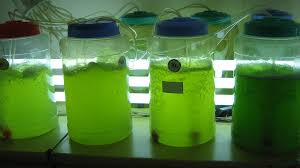Researchers in South Korea have made a major breakthrough in using bacteria to sustainably and efficiently produce biofuels. The team of scientists from the Korea Advanced Institute of Science and Technology (KAIST) report that they have developed a new kind of engineered microorganisms that are capable of producing greater volumes of the fatty acids that make up biodiesel than ever before.
A team of researchers from KAIST released a study detailing their discovery last month in the scientific journal Nature Chemical Biology. The paper. titled “Engineering of an oleaginous bacterium for the production of fatty acids and fuels“ details the development of these record-breaking microorganisms which could prove to be a key breakthrough in the effort to develop sustainable. bio-based energy sources to replace dirtier. finite fossil fuels.
At present. standard biodiesel is produced by transistorizing vegetable oils or animal fats. a process in organic chemistry that creates a reaction exchanging ester for alcohol (like ethanol or biodiesel. the two most common forms of biofuel). This creates a problem. however. as the production of biofuels requires huge amounts of organic material and agricultural products for its creation. taking up valuable land area that could otherwise be used for food production.
This is where the South Korean team’s bacterial breakthrough comes into play. KAIST’s new study has developed an engineered bacterium that is capable of creating more fatty acids than ever before. creating potential for the most efficient form of biofuel production yet.
“Working with engineered Escherichia coli bacteria. a team led by KAIST Distinguished Professor Lee Sang Yup has previously produced short-chain hydrocarbons that can be used as gasoline.“ reports regional science and tech magazine Asian Scientist. “However. their production efficiency of 0.58 g L fell short of the levels required for commercialization.“ This time is different.
“In the present study. Lee and his team used a different strain—Rhodococcus opacus—to produce fatty acids from glucose. one of the most abundant and cheap sugars derived from non-edible biomass.“ explains Asian Scientist. “First. the team optimized the cultivation conditions of R. opacus to maximize the accumulation of oil. which serves as a precursor for the biosynthesis of fatty acids and their derivatives. Then. they systematically analyzed the metabolism of the strain and redesigned it to accumulate higher levels of fatty acids and allow fatty acid ethyl esters and long-chain hydrocarbons to be produced. They found that the resulting strains produced 50.2. 21.3. and 5.2 g L of fatty acids. fatty acid ethyl esters and long-chain hydrocarbons. respectively.“
What this translates to. in layman’s terms. is the highest concentrations of the kind of fatty acids that make up biofuels and biodiesel than ever reported before. These record-breaking microbial fermentations have the potential to revolutionize biofuel. making it more realistic for mass consumption and a better potential replacement for high-emissions fossil fuels like gasoline than ever before.
As quoted by Asian Scientist. Professor Lee said of his team’s breakthrough. “This technology creates fatty acids and biodiesel with high efficiency by utilizing lignocellulose. one of the most abundant resources on the Earth. without depending on fossil fuels and vegetable or animal oils. This will provide new opportunities for oil and petroleum industries. which have long relied on fossil fuels. to turn to sustainable and eco-friendly biotechnologies.“
If the world has any hope of reaching the targets aimed at combating climate change set by the Paris Agreement (which polls show that most U.S. citizens still support. even after President Donald Trump backed out of the agreement. biofuel will have a large role to play in reducing greenhouse gas emissions. So far. however. biofuel just hasn’t been as efficient or affordable as it needs to be to be adopted on a wide scale. A breakthrough like this. however. could go a long way toward tipping the scales toward a greener future.
 Iran Energy News Oil, Gas, Petrochemical and Energy Field Specialized Channel
Iran Energy News Oil, Gas, Petrochemical and Energy Field Specialized Channel




